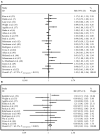Association Between Red and Processed Meat Consumption and Risk of Prostate Cancer: A Systematic Review and Meta-Analysis
- PMID: 35198587
- PMCID: PMC8859108
- DOI: 10.3389/fnut.2022.801722
Association Between Red and Processed Meat Consumption and Risk of Prostate Cancer: A Systematic Review and Meta-Analysis
Abstract
Background: Debate on the potential carcinogenic effects of meat intake is open and the relationship between meat consumption and risk of prostate cancer remains uncertain. This meta-analysis was conducted to summarize earlier prospective studies on the association of meat consumption with risk of prostate cancer.
Methods: Relevant studies were identified by exploring PubMed/Medline, Scopus, Web of Science, EMBASE, and Google Scholar databases up to December 2020. Fixed-effects and random-effects meta-analyses were used for pooling the relative risks (RRs). Heterogeneity across studies was evaluated using the Q-statistic and I-square (I 2). A funnel plot and Egger's test was used to detect publication bias. Linear and non-linear dose-response analyses were performed to estimate the dose-response relations between meat intake and risk of prostate cancer.
Results: Twenty-five prospective studies were included in this meta-analysis. Totally, 1,900,910 participants with 35,326 incident cases of prostate cancer were investigated. Pooling the eligible effect sizes, we observed that high consumption of processed meat might be associated with an increased risk of "total prostate cancer" (RR: 1.06; 95% CI: 1.01, 1.10; I 2 = 1.5%, P = 0.43) and "advanced prostate cancer" (1.17; 1.09, 1.26; I 2 = 58.8%, P = 0.01). However, the association between processed meat and "advanced prostate cancer" was not significant in the random-effects model: 1.12 (95% CI: 0.98, 1.29). A linear dose-response analysis indicated that an increment of 50 grams per day of processed meat intake might be related to a 4% greater risk of "total prostate cancer" (1.04; 1.00, 1.08; I 2 = 0.0%, P = 0.51). "Total meat intake" was marginally associated with all outcomes of prostate cancer risk (1.04; 1.01, 1.07; I 2 = 58.4%, P < 0.001).
Conclusions: This systematic review and meta-analysis of prospective studies indicated that increased consumption of "total meat" and "processed meat" might be associated with a higher risk of prostate cancer.
Systematic review registration: https://www.crd.york.ac.uk/prospero/display_record.php?RecordID=230824, identifier: CRD42021230824.
Keywords: meta-analysis; processed meat; prostate cancer; red meat; total meat.
Copyright © 2022 Nouri-Majd, Salari-Moghaddam, Aminianfar, Larijani and Esmaillzadeh.
Conflict of interest statement
The authors declare that the research was conducted in the absence of any commercial or financial relationships that could be construed as a potential conflict of interest.
Figures






Similar articles
-
Processed red meat intake and risk of COPD: A systematic review and dose-response meta-analysis of prospective cohort studies.Clin Nutr. 2019 Jun;38(3):1109-1116. doi: 10.1016/j.clnu.2018.05.020. Epub 2018 Jun 1. Clin Nutr. 2019. PMID: 29909249
-
Red and processed meat consumption and risk of glioma in adults: A systematic review and meta-analysis of observational studies.J Res Med Sci. 2015 Jun;20(6):602-12. doi: 10.4103/1735-1995.165970. J Res Med Sci. 2015. PMID: 26600837 Free PMC article. Review.
-
Association between processed and unprocessed red meat consumption and risk of nonalcoholic fatty liver disease: A systematic review and dose-response meta-analysis.J Glob Health. 2024 Apr 26;14:04060. doi: 10.7189/jogh.14.04060. J Glob Health. 2024. PMID: 38665062 Free PMC article.
-
Associations of Total Protein or Animal Protein Intake and Animal Protein Sources with Risk of Kidney Stones: A Systematic Review and Dose-Response Meta-Analysis.Adv Nutr. 2022 Jun 1;13(3):821-832. doi: 10.1093/advances/nmac013. Adv Nutr. 2022. PMID: 35179185 Free PMC article.
-
Consumption of red meat and processed meat and cancer incidence: a systematic review and meta-analysis of prospective studies.Eur J Epidemiol. 2021 Sep;36(9):937-951. doi: 10.1007/s10654-021-00741-9. Epub 2021 Aug 29. Eur J Epidemiol. 2021. PMID: 34455534
Cited by
-
Risk factors for prostate cancer: An umbrella review of prospective observational studies and mendelian randomization analyses.PLoS Med. 2024 Mar 15;21(3):e1004362. doi: 10.1371/journal.pmed.1004362. eCollection 2024 Mar. PLoS Med. 2024. PMID: 38489391 Free PMC article.
-
2022 Update on Prostate Cancer Epidemiology and Risk Factors-A Systematic Review.Eur Urol. 2023 Aug;84(2):191-206. doi: 10.1016/j.eururo.2023.04.021. Epub 2023 May 16. Eur Urol. 2023. PMID: 37202314 Free PMC article.
-
Autochthonous Cultures to Improve Safety and Standardize Quality of Traditional Dry Fermented Meats.Microorganisms. 2023 May 17;11(5):1306. doi: 10.3390/microorganisms11051306. Microorganisms. 2023. PMID: 37317280 Free PMC article. Review.
-
Plant-Based Diets and Disease Progression in Men With Prostate Cancer.JAMA Netw Open. 2024 May 1;7(5):e249053. doi: 10.1001/jamanetworkopen.2024.9053. JAMA Netw Open. 2024. PMID: 38691361 Free PMC article.
-
Causal relationship between prostatic diseases and prostate cancer: a mendelian randomization study.BMC Cancer. 2024 Jun 27;24(1):774. doi: 10.1186/s12885-024-12551-9. BMC Cancer. 2024. PMID: 38937672 Free PMC article.
References
Publication types
LinkOut - more resources
Full Text Sources

